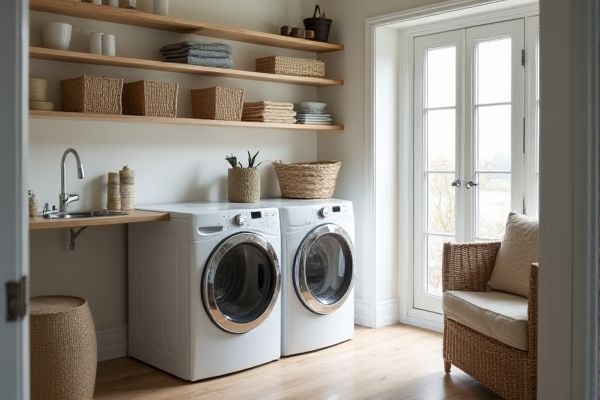
Vented dryers expel moist air outside through a duct, making them efficient but requiring outdoor access, while condenser dryers collect moisture internally, offering flexible placement without external venting. Discover which dryer type best suits your home and drying needs by reading the rest of the article.
Table of Comparison
| Feature | Vented Dryer | Condenser Dryer |
|---|---|---|
| Drying Mechanism | Expels hot, moist air through a vent | Condenses moisture into water tank or drain |
| Installation | Requires external vent or duct | No vent needed; portable setup |
| Energy Efficiency | Generally less efficient | More energy-efficient with heat pump models |
| Location Flexibility | Limited to areas with vent access | Can be placed anywhere indoors |
| Cost | Lower initial cost | Higher purchase price |
| Maintenance | Maintain vent ducts regularly | Empty water tank or check drain |
| Drying Time | Faster drying | Usually slower drying |
Introduction to Vented and Condenser Dryers
Vented dryers expel moist air outside through a duct, requiring proper installation near an external vent, making them energy-efficient but dependent on room ventilation. Condenser dryers collect moisture from clothes as water, stored in a reservoir or drained away, allowing flexible placement without ventilation but typically consuming more energy. Choosing between vented and condenser dryers depends on available space, installation options, and energy considerations.
How Vented Dryers Work
Vented dryers operate by drawing in air from the surrounding environment, heating it to evaporate moisture from clothes, and then expelling the humid air outside through a vent hose. This process requires a direct connection to an external vent, making vented dryers ideal for spaces with easy access to outdoor ventilation. Their efficient moisture removal system allows for shorter drying cycles and lower energy consumption compared to condenser dryers.
How Condenser Dryers Work
Condenser dryers operate by drawing moist air from the drum and passing it through a heat exchanger, where the moisture condenses into water collected in a reservoir or drained away. This process eliminates the need for external venting, making condenser dryers suitable for apartments or spaces without vent access. Their closed-loop system recirculates warm air, providing efficient drying while maintaining indoor air quality.
Energy Efficiency Comparison
Condenser dryers generally consume more energy than vented dryers due to their heat exchange process, which reuses warm air to condense moisture. Vented dryers expel hot, moist air directly outside, typically resulting in shorter drying cycles and lower energy use. Energy ratings often favor vented models for their efficiency, although modern condenser dryers with heat pump technology can offer comparable or superior energy savings.
Installation Requirements and Flexibility
Vented dryers require an external vent to expel moist air, necessitating installation near a window or wall with proper ductwork, limiting placement options. Condenser dryers condense moisture into water, which is collected in a tank or drained away, allowing installation in enclosed spaces without external vents. This flexibility makes condenser dryers ideal for apartments or rooms without outside access.
Drying Performance and Speed
Vented dryers typically offer faster drying times due to their ability to expel moist air directly outside, enhancing performance by maintaining efficient heat and airflow. Condenser dryers, while slower, provide flexible installation since they do not require external venting, using a heat exchanger to condense moisture into a water tank or drain. Both types vary in drying efficiency depending on load size and fabric type, but vented models generally excel in speed and intensity of drying cycles.
Maintenance and Upkeep Differences
Vented dryers require regular cleaning of the lint filter and ensuring the external vent pipe is free from blockages to maintain efficient airflow and prevent fire hazards. Condenser dryers need frequent emptying of the water collection container and periodic cleaning of the condenser unit to avoid moisture buildup and maintain optimal drying performance. Both types benefit from routine maintenance but differ in the specific components that must be cared for to ensure longevity and efficiency.
Cost Analysis: Purchase and Operating Costs
Vented dryers generally have a lower purchase price, averaging $300 to $600, compared to condenser dryers, which typically range from $500 to $900. Operating costs favor vented dryers due to their simpler design and shorter drying times, resulting in lower energy consumption, while condenser dryers use more electricity because they rely on a heat exchanger and often have longer cycles. Maintenance expenses are slightly higher for condenser dryers due to the need for regular lint filter and water tank cleaning, whereas vented dryers require minimal upkeep beyond ensuring the vent duct remains unobstructed.
Suitability for Different Home Types
Vented dryers require an external vent to expel hot, moist air, making them ideal for homes with accessible exterior walls or windows. Condenser dryers condense moisture internally and collect it in a reservoir or drain it away, fitting perfectly in apartments or spaces lacking external ventilation. Understanding your home's layout helps determine which dryer type aligns with your installation options and space constraints.
Pros and Cons Summary
Vented dryers offer faster drying times and lower purchase costs but require external venting, which limits installation options and can lead to heat loss and moisture buildup outside. Condenser dryers are easier to install anywhere since they don't need external vents, recycling moisture into water collection tanks or drainage systems, but they typically consume more energy and may take longer to dry clothes. Your choice depends on available space, energy efficiency preferences, and installation flexibility.
 homyna.com
homyna.com